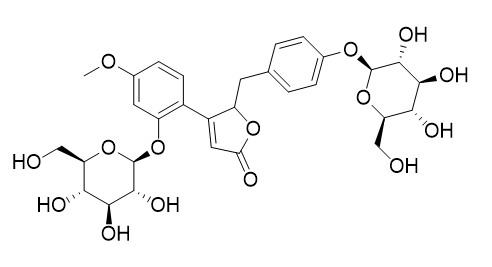Pueroside B
Pueroside B may can treat coronary heart disease, it can interact with two or more targets[peroxisome proliferator activated receptor γ (PPAR-γ), angiotensin-converting enzyme (ACE), hydroxymethylglutaryl coenzyme A receptor (HMGR), cyclooxygenase-2 (COX2), and thrombin].
Inquire / Order:
manager@chemfaces.com
Technical Inquiries:
service@chemfaces.com
Tel:
+86-27-84237783
Fax:
+86-27-84254680
Address:
1 Building, No. 83, CheCheng Rd., Wuhan Economic and Technological Development Zone, Wuhan, Hubei 430056, PRC
Providing storage is as stated on the product vial and the vial is kept tightly sealed, the product can be stored for up to
24 months(2-8C).
Wherever possible, you should prepare and use solutions on the same day. However, if you need to make up stock solutions in advance, we recommend that you store the solution as aliquots in tightly sealed vials at -20C. Generally, these will be useable for up to two weeks. Before use, and prior to opening the vial we recommend that you allow your product to equilibrate to room temperature for at least 1 hour.
Need more advice on solubility, usage and handling? Please email to: service@chemfaces.com
The packaging of the product may have turned upside down during transportation, resulting in the natural compounds adhering to the neck or cap of the vial. take the vial out of its packaging and gently shake to let the compounds fall to the bottom of the vial. for liquid products, centrifuge at 200-500 RPM to gather the liquid at the bottom of the vial. try to avoid loss or contamination during handling.
J Ethnopharmacol.2017, 209:305-316
Eur J Pharmacol.2024, 975:176644.
Molecules.2016, 21(6)
J Ginseng Res.2020, 44(4):611-618.
Food Chem.2019, 276:768-775
J Integr Plant Biol.2023, 13564.
Int Immunopharmacol.2023, 7:127:111322.
J Funct Foods2019, 54:449-456
Foods.2021, 10(12):2929.
J Cancer.2019, 10(23):5843-5851
Related and Featured Products
J Ethnopharmacol. 2014 Mar 28;152(3):594-8.
Protective effects of puerariae radix extract and its single compounds on methylglyoxal-induced apoptosis in human retinal pigment epithelial cells.[Pubmed:
24486213]
In Korea, Puerariae radix is a medicinal plant traditionally used to treat various diseases including diabetes mellitus. To provide pharmacological basis for Puerariae radix in the treatment of diabetes, we investigated the protective effects of the ethanolic extract and its single compounds on apoptosis associated with glycation in human retinal pigment epithelial (RPE) cells.
METHODS AND RESULTS:
In the present work, a quantified ethanolic extract or single compounds of Puerariae radix were selected to determine its anti-apoptotic effect in human RPE cells cultured with methylglyoxal (MG), which is a stimulator of glycation. To assess the protective effect of the extract or single compounds, the cytotoxicity assessment was performed using an MTT assay in the human RPE cells. Selected active compounds or extracts were tested by FACS analysis with annexin V staining for apoptosis.
Daidzein (1), daidzin (2), puerarin (3), 3'-hydroxy-daidzein 8-C-apiosyl (1→6) glucoside (4), and daidzein 8-C-apiosyl (1→6) glucoside (5), and Pueroside B (6) were isolated from an ethanolic extract of Puerariae radix. MG-induced apoptosis was completely inhibited by Puerariae radix, ethanolic extract, and single compounds. Of the six major compounds, daidzin (2) and 3'-hydroxy-daidzein 8-C-apiosyl (1→6) glucoside (4) significantly inhibited MG-induced apoptosis.
CONCLUSIONS:
Our results provide the first evidence that, due to its anti-glycation effect, Puerariae radix extract could inhibit MG-induced apoptosis in the cultured human RPE cells. These data suggest that Puerariae radix extract, especially its single compounds daidzin and 3'-hydroxy-daidzein 8-C-apiosyl (1→6) glucoside, has potential utility as a preventive agent for glycation-related diabetic retinopathy.
ACTA PHYSICO-CHIMICA SINICA, 2012, 28(5).
Molecular Docking in Xin-Ke-Shu Preparation's Multi-Target Effect on Coronary Heart Disease.[Reference:
WebLink]
Xin-Ke-Shu (XKS), a traditional Chinese medicine (TCM) preparation, has been widely used for treatment of coronary heart disease (CHD) in China. However, the active constituents of XKS and their interactions with targets remain unclear.
METHODS AND RESULTS:
In this study, we assessed two docking programs, LibDock and AutoDock, by calculating the root-mean-square deviation (RMSD) of X-ray structure reproduction and the enrichment factor (EF) in virtual screening; both proved to be practical in our protein-ligand complex systems. Moreover, the combined use of the two programs yielded better EFs for each target. We therefore used a combination of the two programs to investigate the interactions of the 51 chemical constituents identified from XKS with five CHD targets, namely peroxisome proliferator activated receptor γ (PPAR-γ), angiotensin-converting enzyme (ACE), hydroxymethylglutaryl coenzyme A receptor (HMGR), cyclooxygenase-2 (COX2), and thrombin.
CONCLUSIONS:
The docking results suggest that pueroside A, Pueroside B, salvianolic acid A, and salvianolic acid C can interact with two or more targets, and the other eight compounds may be potent for at least one of the five targets. In this research, we propose a strategy for studying TCM preparations, and suggest that XKS has a multi-target effect on CHD.



